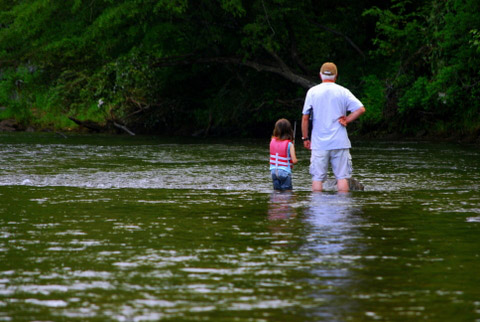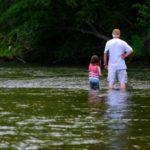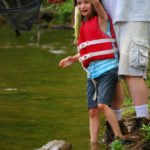
Set up enjoyable outing and hook them for life
The first Saturday in June, delayed-harvest trout waters switch from catch-and-release to catch-and-keep fishing. Streams are crowded, and due to the large numbers of trout that have been stocked, just about everyone goes home with a limit of seven trout. Unfortunately, a few greedy scofflaws return for additional limits.
The first part of the day, from 6 a.m. to noon, fishing in delayed-harvest waters across the western end of the state is limited to kids under 16 years old. With no competition from older and more experienced trout fishers, kids can enjoy the thrill of catching and landing a trout. Even if it is a once-year-event, it’s ideal opportunity to teach a child to fish. The N.C. Wildlife Resources Commission should consider other similar ways to get youths interested in fishing. The Commission has everything to gain and nothing to lose.
On that June morning, I took my two granddaughters, ages six and nine, to the delayed-harvest section of the Tuckasegee River in Jackson County. It was the first trout-fishing outing for the younger granddaughter, and within an hour, she had hooked and reeled in four nice trout — two brook trout, one rainbow and one brown — all stockers, of course, but to a child, a trout is a trout.
The stream was wadable even for the smaller girl. I took them out in the center and let them fish, using spinning tackle and live bait. The older girl can cast without help, but the younger need help casting. On the second cast, the line suddenly went taut, and she caught her first trout ever, reeling it in by herself. Watching her reel in the struggling trout was as much a thrill for me as it obviously was for her. I let her hold and examine each trout, pointing out the distinguishing features of each species.
The older granddaughter caught two trout and the biggest — a 12-inch rainbow. We had agreed beforehand that we would keep only enough trout for a family dinner, and when we had six, we quit.
That evening we had a magnificent meal of fried trout, coleslaw and fried new potatoes and onions. Since the girls caught the fish, they were rewarded with the prized cheek-meat, the tiny scallops located behind the eyes.
Patience is a prime requirement for teaching kids to fish. Start with simple gear such as a closed-face reel or spinning tackle. Let them dry-cast until they become proficient at handling a rod and reel before they get on the stream. The frustration factor will be much lower.
Start with live bait (most everyone does). It’s a fool-proof method of catching a trout. Show them how to bait a hook and tie line to a hook using a simple knot, something little hands can easily master.
Don’t make the initial outings marathon sessions. Kids get tired and bored easily, especially if the fish aren’t biting. On initial outings, take kids to streams that are stocked frequently so the chances of actually catching a trout are good.
Stream-by-stream stocking schedules are posted on the Commission’s web page. Most streams are stocked monthly from March through June, but a few, such as the Davidson River in Transylvania County, the South Toe River in Yancey County, the Middle Fork of the New River in Watauga County, the North Fork of the New River in Ashe County, the Little River in Alleghany County and the East Prong of the Roaring River in Wilkes County are stocked monthly through August.
Teach kids to respect the resource and take only what they plan to eat that day. The only way to truly enjoy a trout is to eat it the same day you catch it. Even overnight storage in a refrigerator reduces the quality of the meat.
Don’t plan to fish when you take a child on an outing. You’ll be busy enough baiting and rebaiting, tying on hooks, freeing snagged lines and assisting with navigating rocky streambeds.
Guide the child through the total experience of fishing, from catching a fish, landing it, cleaning it, and, the best part, eating it.
When that child masters the basics of fishing without assistance, you can then move to more sophisticated methods of fishing, such as fly fishing.
If you do your job well enough, you’ll have a fishing partner for life.






Be the first to comment